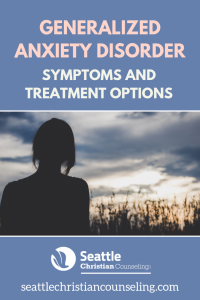 Most of us are familiar with various symptoms of anxiety, such as a nervous stomach, racing pulse, restlessness, or worrying thoughts in response to a stressor. Almost everyone can think of a new experience, challenging conversation, or scary situation that elicited these reactions.
Most of us are familiar with various symptoms of anxiety, such as a nervous stomach, racing pulse, restlessness, or worrying thoughts in response to a stressor. Almost everyone can think of a new experience, challenging conversation, or scary situation that elicited these reactions.
At times, anxiety is highly beneficial; it alerts us to harm, protects us from potential danger, and heightens our ability to react as needed to specific situations. However, anxiety is problematic when it occurs excessively and gets in the way of living the life we want.
If you or a loved one has experienced an anxiety disorder, you may know firsthand the way anxiety can take over your life and consume your thoughts. Or, you may be experiencing anxiety symptoms acutely for the first time and wondering what you can do to get your life back. The good news is, there is hope and there are a number of effective treatments available.
First, it is helpful to distinguish anxiety from fear, and to distinguish anxiety as a diagnosable disorder from anxiety as a typical part of the human experience.
Anxiety Compared to Fear
Fear and anxiety have similarities as well as important distinctions. Looking at similarities, both fear and anxiety can elicit similar physiological responses geared toward protecting us from danger. In terms of differences, according to the DSM-5, fear is an “emotional response to real or perceived imminent threat” while anxiety is “anticipation of a future threat.”
Fear tends to be more closely associated to the “fight or flight” response and is elicited by a specific and immediate threat, while anxiety tends to be more linked to avoidance behaviors and can be elicited by something less concrete.
In other words, while there can be overlap and connections between fear and anxiety, fear is linked to an identifiable and present danger, whereas anxiety is often tied to the unease or apprehension of something that a person expects to happen or is worried may happen.
Anxiety Compared to Anxiety Disorders
“Anxiety disorder” is an umbrella term for a group of diagnoses, each with a specific set of symptoms. Anxiety disorders differ from typical anxiety in several ways. In an anxiety disorder, the intensity, frequency, and duration of anxiety lasts longer.
Additionally, as opposed to anxiety, symptoms of an anxiety disorder may occur in the absence of a specific stressor and often manifest along with additional physical or cognitive symptoms.
The symptoms of an anxiety disorder also cause a person to feel significantly distressed and impair their ability to function well in one or more areas of their life.
Generally speaking, anxiety disorders are identified by excessive panic or anxiety, and can also be associated with certain cognitive and behavior patterns. Under the broad category of anxiety disorders, there are a number of specific diagnoses, each with a different list of criteria and features in addition to these core characteristics.
***
PIN THIS:

***
Symptoms of Generalized Anxiety Disorder
Generalized Anxiety Disorder is one diagnosis that falls within the category of anxiety disorders; it is characterized by persistent worry about a variety of concerns that an individual finds challenging to control.
In order to be diagnosed with Generalized Anxiety Disorder, an individual must meet certain diagnostic criteria. For example, an individual must experience symptoms more often than not over the course of at least six months and report disproportionately high anxiety in regards to multiple areas of life.
An individual must also report at least three of the following (from the DSM-5):
- Restlessness or feeling keyed up or on edge
- Being easily fatigued
- Difficulty concentrating or mind going blank
- Irritability
- Muscle tension
- Sleep disturbance
What do these symptoms look like in daily life? This may feel like an inability to relax or calm down, both physically and cognitively. An individual may feel pain or tension in their head, neck, chest, or other areas of their body.
 Anxiety may manifest as a sense of urgency, a need to always be moving or doing something, or a constant fear that something bad is about to happen. An individual may report that they are always tired, or that they can’t even remember the last time they felt rested.
Anxiety may manifest as a sense of urgency, a need to always be moving or doing something, or a constant fear that something bad is about to happen. An individual may report that they are always tired, or that they can’t even remember the last time they felt rested.
At the same time, they may have difficulties falling asleep, wake up in the middle of the night to an active mind rehearsing distressing scenarios over and over, or start each morning feeling as if they didn’t get a good night’s sleep.
Some people experience challenges with focusing on one thing at a time; their mind seems to have a mind of its own, making it difficult to concentrate on the task or situation at hand. At other times, they may feel as if their mind is completely shut down and they aren’t able to access any thoughts at all. Others find that they are irritated by things that wouldn’t normally bother them, or that they have trouble not getting worked up over things they wish they could brush off.
Another trait associated with Generalized Anxiety Disorder is chronic worries. These are often focused on day-to-day situations, such as tasks at work, physical health, and other regular happenings in life.
Although most people report feeling worried about various issues from time to time, someone with Generalized Anxiety Disorder may feel worried virtually all the time. They may recognize that their worry and anxiety is focused on “minor” things, but at the same time feel powerless to stop.
These individuals may also find that the focus of their worry shifts over time. Additionally, these worries are typically more intense and distressing than the situation warrants, and the thoughts can pop up without provocation.
It is imperative to note that this is not the exhaustive list of criteria for Generalized Anxiety Disorder. If you believe these symptoms describe you or a loved one, it is important to speak with a doctor to rule out physical causes.
Additionally, a licensed mental health provider can help rule out differential diagnoses and support you with treatment options. It is also important to keep in mind that Generalized Anxiety Disorder varies in the way it manifests from person to person, as well as across cultures. For example, in some cultures, individuals may experience primarily physical symptoms, while individuals in other cultures may report more acute cognitive symptoms.
Treatment Options for Generalized Anxiety Disorder
For individuals with Generalized Anxiety Disorder, the idea of finding peace can feel overwhelming, but there are promising treatments, such as medication and therapy.
One type of therapy that has been shown to be effective with Generalized Anxiety Disorder is Cognitive Behavioral Therapy. Cognitive Behavioral Therapy is a type of behavioral talk therapy that explores the way our thoughts, feelings, and behaviors are connected. There are several ways Cognitive Behavioral Therapy may be applied in counseling sessions.
Psychoeducation
Psychoeducation refers to providing a client with information about their diagnosis, how treatment works and why, and other related knowledge. This is useful to promote greater understanding and collaboration in the therapeutic relationship.
By understanding the potential causes of Generalized Anxiety Disorder, identifying the specific ways it manifests, and learning about effective treatments, an individual may feel empowered, hopeful, and less alone.
Generalized Anxiety Disorder is a mental health diagnosis, not a character flaw or weakness, and for individuals who are suffering, separating facts from myths can be liberating.
Thoughts
Distressing worry thoughts are a hallmark of Generalized Anxiety Disorder, so identifying automatic thoughts, recognizing cognitive distortions, and replacing them with more effective thought patterns can be enormously beneficial.
 Someone with Generalized Anxiety Disorder may overgeneralize danger, catastrophize situations, and underestimate their ability to cope. There are a number of specific skills that can be taught in therapy to target these tendencies and empower individuals to regain control over their thoughts.
Someone with Generalized Anxiety Disorder may overgeneralize danger, catastrophize situations, and underestimate their ability to cope. There are a number of specific skills that can be taught in therapy to target these tendencies and empower individuals to regain control over their thoughts.
By examining these patterns of thinking and learning more effective thought strategies, we can challenge harmful automatic assumptions and practice new ways of processing thoughts.
Mindfulness
Mindfulness is a tool to help us focus our minds on the present. Because anxiety is geared toward future worries, mindfulness is a powerful way to provide relief.
There are numerous helpful mindfulness skills, techniques, and methods for re-training our minds to live in the present and to significantly reduce anxiety symptoms. These practices can be taught and implemented in daily life to help an individual diminish the troublesome effects of Generalized Anxiety Disorder.
Relaxation
Similar to mindfulness, relaxation skills help to alleviate physical symptoms of anxiety. Individuals may discover that they have been living in a state of physical tension and muscle clenching without even realizing it.
By learning to relax our muscles and bodies, we send calming signals to our minds as well. Simple changes, from the way we configure our facial muscles to the way we posture our bodies or hold our hands, can have a profound impact on our emotional state.
Problem-solving
There is a strong link between anxiety and stressors in our lives. By becoming more equipped with problem-solving strategies, we can alleviate some of the situations we encounter that are stress-inducing and increase our confidence in our own abilities.
Certain problems may feel overwhelming or unsolvable, and anxiety or worry can result in a tunnel vision that limits our perspective to potential solutions. Counseling can be enormously helpful by encouraging new perspectives, teaching specific problem-solving skills, and brainstorming a variety of solutions to problems.
What to Expect From Christian Counseling for Generalized Anxiety Disorder
“I’m stuck in anxiety quicksand: The harder I try to climb my way out, the lower I sink.” — Glennon Doyle Melton, Love Warrior
A heartbreaking misconception about anxiety that sometimes stems from a Christian lens is that if you just have stronger faith or pray more or become a “better” Christian, your anxiety will disappear.
Individuals may believe that it is their responsibility to climb out of the “quicksand of anxiety” on their own and that failed attempts to find peace are indicative of a deep-seated character flaw.
However, Generalized Anxiety Disorder is not your fault; it is not a sign of spiritual failure or a punishment. Generalized Anxiety Disorder can result from a number of factors including trauma, biological predispositions, environmental causes, or prolonged stressors.
The beauty of Christian counseling is that it offers support that recognizes the ways spirituality can be intertwined in all aspects of our lives, and treatment builds on a foundation of spiritual truths that offer us healing and peace.
 I do not believe that Christianity or spirituality is at odds with evidenced-based treatment; on the contrary, I see them as profound complements to each other.
I do not believe that Christianity or spirituality is at odds with evidenced-based treatment; on the contrary, I see them as profound complements to each other.
For example, many Christians find comfort in the words of Jesus:
“Give your entire attention to what God is doing right now, and don’t get worked up about what may or may not happen tomorrow. God will help you deal with whatever hard things come up when the time comes” (Matthew 6:34, The Message). These words are an exquisite illustration of the ways Christianity overlaps with mental health concepts and skills such as mindfulness.
Earlier in Matthew, Jesus also shares, “Come to me, all you who are weary and burdened, and I will give you rest. Take my yoke upon you and learn from me, for I am gentle and humble in heart, and you will find rest for your souls. For my yoke is easy and my burden is light” (Matthew 11:28-30).
Jesus invites us into a new way of living that offers something radically different from anything else on this earth. The promise of “rest for your souls” is captivating to many people, and acutely hopeful for someone struggling with Generalized Anxiety Disorder.
I believe that incorporating the teachings of Jesus and other spiritual truths in counseling is a powerful way to experience peace. As Christians, we believe that God is actively working in our lives, and Christian counseling is one way to dig deeper into that truth.
The approach to Christian counseling can vary greatly from provider to provider. My approach, specifically, is tailored to each individual. I understand that terms such as religion, church, spirituality, God, Jesus, and the Bible can elicit powerful responses from people. Responses may range from shame, hatred, or disgust to joy, curiosity, or hope, and everything in between.
I recognize that some people have been hurt by the church or by Christians and want nothing to do with it at all. Some people may be grappling with what they believe, and some may have found incomparable freedom in their faith that they yearn to explore further. I welcome everyone, no matter where they stand or what experiences they bring to our sessions. My goal is to meet you exactly where you are and work together toward the healing you desire.
Help and support are available, and taking the first step may require a great deal of courage. Counseling can be incredibly effective in alleviating the debilitating impact of Generalized Anxiety Disorder. I invite you to reach out to myself or another mental health professional to schedule your initial risk-free appointment.
References
American Psychiatric Association. (2013). Diagnostic and statistical manual of mental disorders (5th ed.). Washington, DC: Author.
Borza L. (2017). Cognitive-behavioral therapy for generalized anxiety. Dialogues in clinical neuroscience,
19(2), 203-208.
http://cogbtherapy.com/generalized-anxiety-disorder-treatment
Doyle Melton, G. (2017) Love Warrior: A Memoir. New York, NY: Flatiron Books.
https://www.psychiatry.org/patients-families/anxiety-disorders/what-are-anxiety-disorders
Photos:
“Foggy Road”, Courtesy of Katie Moum, Unsplash.com, CC0 License; “Mist Among Tall Trees”, Courtesy of Lukas Neasi, Unsplash.com, CC0 License; “Dandelion”, Courtesy of Saad Chaudhry, Unsplash.com, CC0 License; “Sun Shining on Forest Floor”, Courtesy of Janus Clemmensen, Unsplash.com, CC0 License





